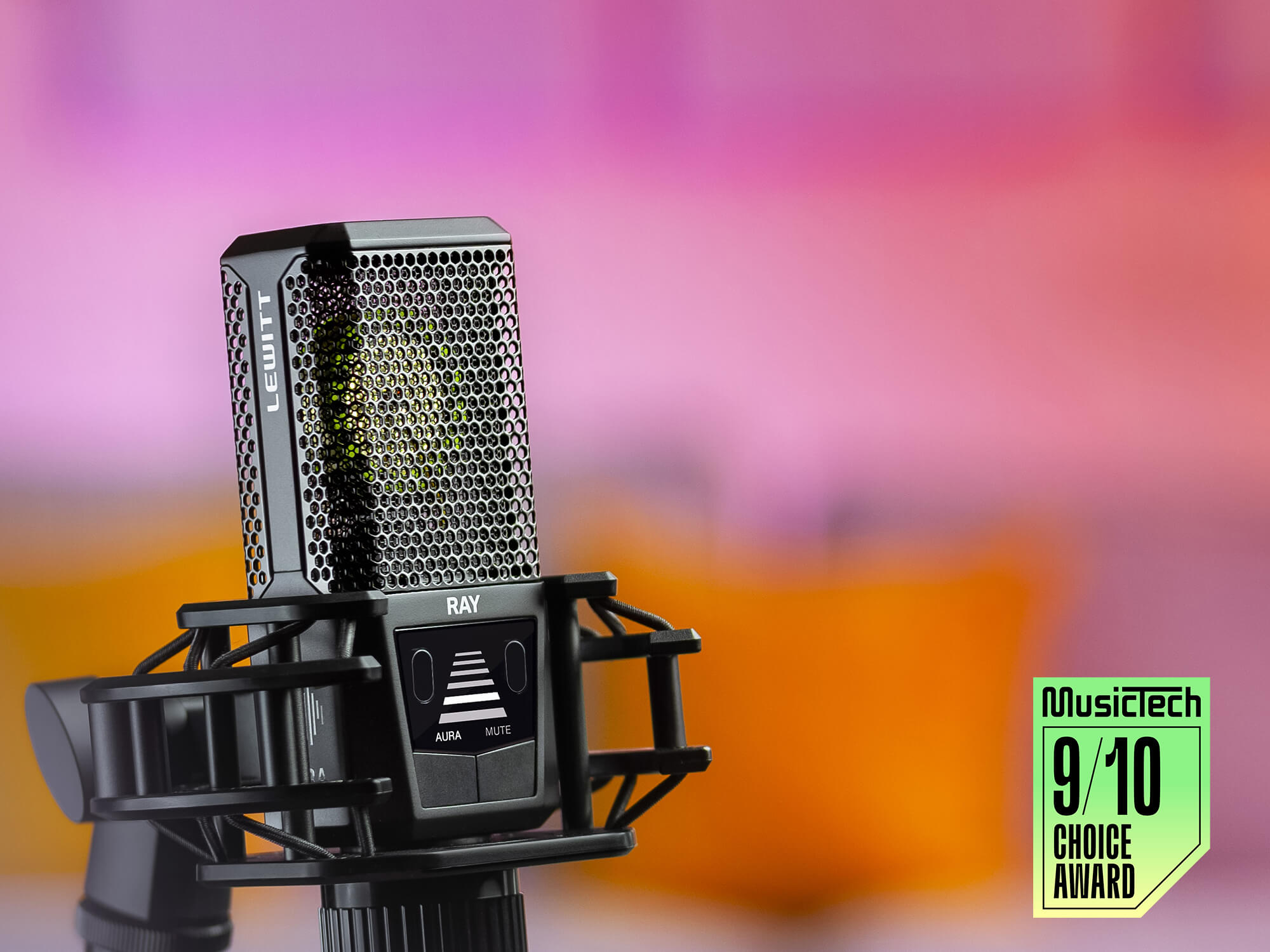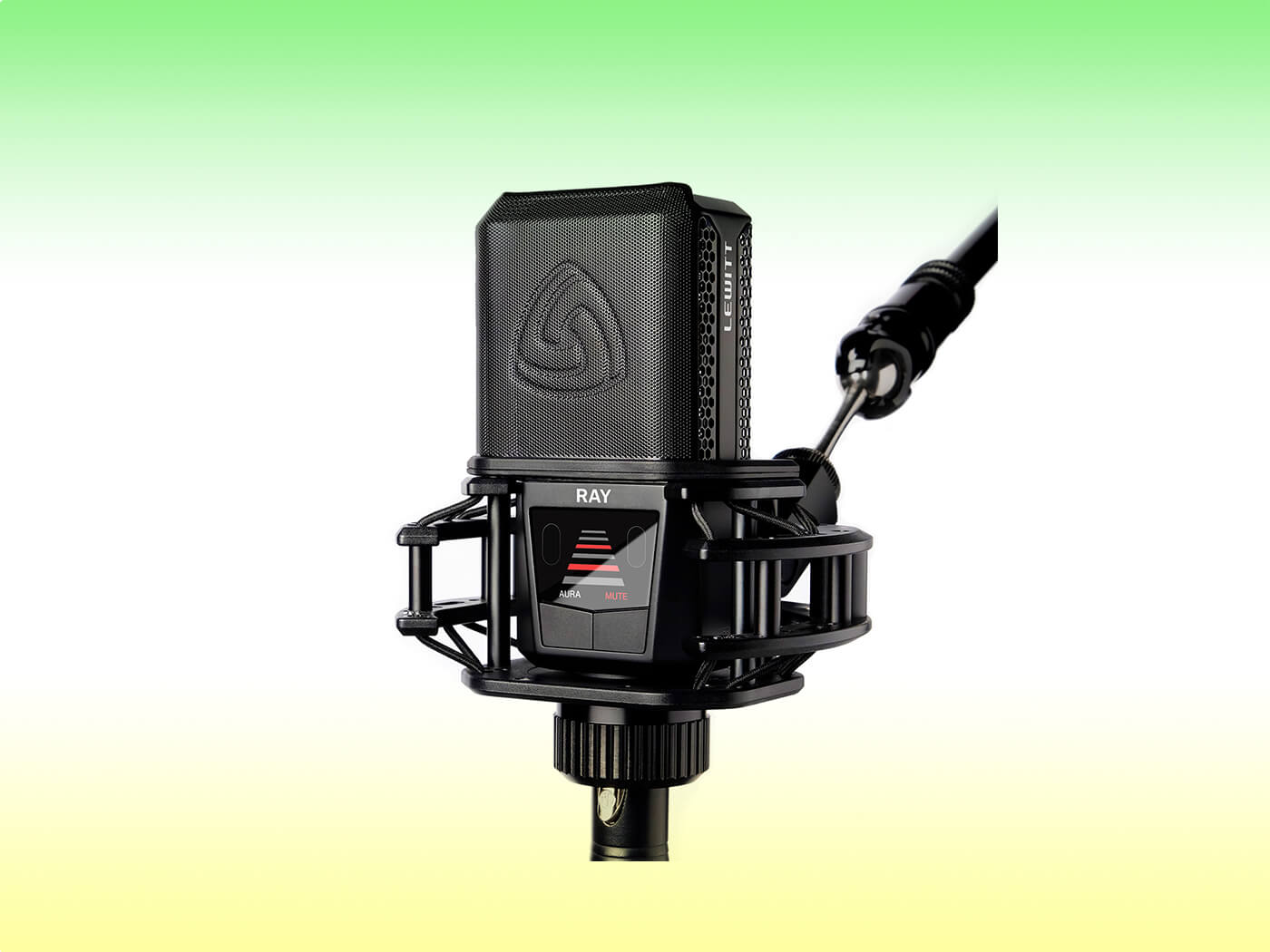Lewitt’s Ray microphone tries to solve an age-old problem with recording vocals
Groundbreaking new AURA technology could revolutionise the way you record vocals – using invisible sensors.

Lewitt Audio Ray
Review Overview
Our rating
9
Our verdict
⊕ Impressive build and accessories
⊕ Super simple to use
⊕ Voice autofocus really works
⊕ Mute by distance handy for podcasters
⊖ AURA tech likely precludes use of more than one polar pattern
£299/$349, lewitt-audio.com
The fundamentals of studio microphone technology have remained relatively static over the years, with few major developments in recent decades — except for the now-common all-in-one USB microphone. Rarely does a manufacturer try to address an issue which is just sort of accepted as an inconvenient part of the recording process But that is what Lewitt has done with its new Ray microphone. So how is it different from other microphones?
Ray looks like a conventional all-analogue studio condenser mic, connected to your interface by XLR and using phantom power. It ships with a shockmount and a magnetic pop filter that attaches neatly to the body and is small enough not to look unsightly should you be using the mic on camera. The build quality and finish are excellent, and it looks pretty cool too.
Ray’s unique innovation is what the company calls “autofocus for your voice”. Anyone who has used a microphone knows that your voice gets quieter and thinner the further away you are from it, and increasingly loud and boomy as you come up close. The way this has always been managed has been to regulate your physical distance, being careful not to go too close or too far away when speaking or singing. It’s so ingrained that you don’t really think about it – but what if there was another way?
Lewitt has come up with a system it calls AURA which, when activated, is able to dynamically adapt the microphone’s level and tonal qualities based on your distance from it. It all happens inside the mic with a microcontroller adjusting the signal according to distance, all in the analogue domain so that no latency is introduced.
This is activated using a simple button on the mic — otherwise it just operates in regular, non-adjusting mode — and is something of a revelation. You can move back and forth by a couple of feet (obviously not really far because there are practical limits) and the level remains consistent. Producers would normally use some compression to achieve a similar if not identical result, though that can come with the issue of latency and the effect is also printed onto your take. And riding a gain fader during recording is not really practical.

With the dynamic feature on you quickly forget that you are not supposed to be shifting position since the audio level in your headphones doesn’t change – it’s surprisingly easy to get used to. When you get very close to the mic, male voices especially will exhibit more low end but the proximity effect isn’t evident and you do have to get really quite close to experience this anyway.
There’s a second feature that uses the AURA technology and that’s “mute by distance”, the other button on the mic body. Choose one of several pre-set distances and when you move further away the mic will mute itself. Again, you can approximate it using a software or hardware noise gate, but finding the right threshold setting can be fiddly.
The practical uses for this are pretty compelling. For singers it means you can step back between takes or verses, muting the mic and ensuring that bleed, background noise or off-mic chatter are not picked up, saving editing time later. For podcasters, it means you can swing the mic off to one side if it’s on a boom, or physically move back to temporarily mute the mic. This doesn’t mean that you’ll have to do no editing, mixing or processing after recording but it can cut down on the amount of work by letting people mute and unmute themselves in real time.
Whether you use these features or not, Ray delivers a clean and neutral-sounding signal via its one-inch gold-sputtered capsule with a cardioid pickup pattern that rejects sound from behind. There’s a very low self-noise level of 8dB and a sound pressure upper limit of 131 dBSPL so loud performances aren’t a problem. Favoured by engineers and producers working with artists including Justin Bieber and the Rolling Stones, Lewitt’s mics enjoy a good reputation and certainly here it’s well justified.

Is the AURA stuff enough to make Ray stand out in this price bracket? We think so.
It’s a stellar mic to begin with — if it wasn’t, no extra features could make up for that. But these are genuinely useful additions. While both the auto-gain and the auto-mute will be helpful for all users, we’d suggest that the gain will be particularly appreciated by singers, who tend to move to differing extents during a performance and whose vocals can naturally vary in volume. If you want to capture those variations you can of course just turn the gain feature off.
Small variations in volume are less of a problem for streamers or podcasters but many could still make use of the auto gain. For these people, being able to mute yourself while others speak for longer periods by just moving back slightly will also be a really useful thing to be able to do. While these are mostly possible to achieve in a more long-winded and arguably less effective format by using live mixing or plugins, here it’s super simple. Just a couple of button presses on the mic will do it.
The price, while reasonable for a high-performing studio mic, might count out more casual content creators. Otherwise, Ray is an easy recommendation for anyone recording vocals, be it singing, spoken word, podcast or voiceover. Being analogue, it’s going to have to be connected to an interface or mixer with phantom power so perhaps not one for the run-and-gun crowd, but Ray is an innovative solution to a problem so long established in the recording world that we had stopped noticing it was a problem.
Lewitt Ray key features
- Cardioid condenser microphone
- 1-inch gold sputtered capsule
- AURA technology for voice autofocus
- Mute by distance feature
- “Record-ready” sound
- Supplied with shock mount and magnetic pop shield
- 8 dB self-noise
- 131 dBSPL sound pressure tolerance
- Configurable distance mute settings
- Works as regular mic with autofocus turned off